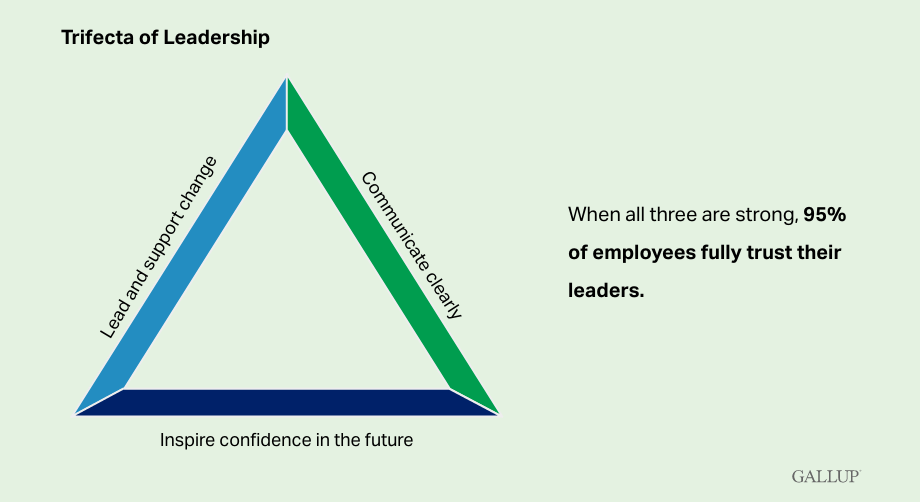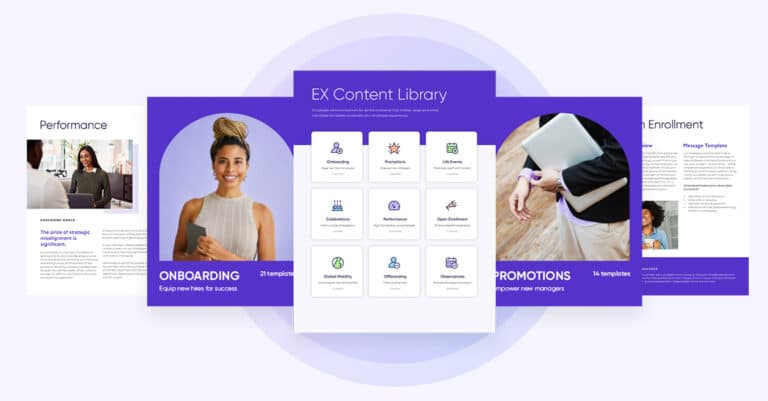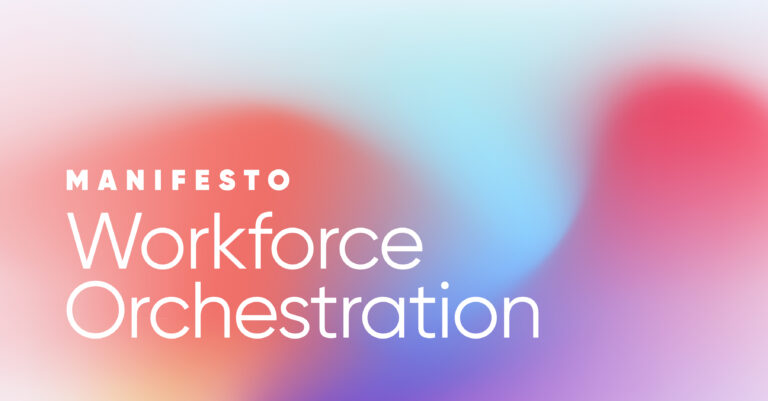As we look to 2025, it’s tempting to dive into the same old trends that everyone seems to talk about. But let’s be honest: Trends can sometimes feel like yesterday’s news, and they don’t always offer the value you need to navigate real change.
So instead of just riding the wave of what’s “trendy,” we’re bringing you something more valuable: predictions. Our top Firstup internal communication and employee experience (EX) experts aren’t just following the crowd; they’re forecasting the game-changing shifts you actually need to prepare for in 2025.
Forget about buzzwords and empty trends. Let’s talk about what’s really coming and how you can future-proof your strategy to stay connected with your workforce in ways that matter.
Get ready to leave trends in the dust and embrace what’s next!
Executives engage more, authentically
With only 50% of employees thoroughly reading messages sent from leaders, and only 20% strongly agreeing that their leaders communicate effectively (Gallup), we’re starting to see more executives embrace interactive, authentic ways to communicate with employees and stakeholders — a trend I expect to grow in popularity in 2025 and beyond.

While communicators will still be called on to assist, frame, and plan for leader communications, the most savvy execs are increasingly carving out time to actively participate — on their own — in ways that showcase their unique perspectives and personalities.
Gone are the days of longform CEO letters or formal messages fully ghostwritten by communicators. Today’s leaders are partnering with comms professionals to map out strategic plans and producing video updates using their own mobile devices. They are enthusiastically hosting “Ask Me Anything” interactive Q&A sessions done in chat style, through video, or in place of formal town halls, and they are using snapshots and quick videos to recognize employees doing great work and then sharing on an internal platform.
For example, in his long-running “Marc’s Whirld” topic in Firstup, Whirlpool CEO Marc Bitzer gives video answers to employee questions, spotlights workers in photos from different locations, and posts quarterly updates. Regional managers at Raising Cane’s Chicken Fingers upload videos (shot on their phones), sharing updates with team members who missed in-person operations huddles.
As more leaders lean into these dynamic, authentic communication styles, they’re not only building trust but also fostering a culture of transparency and engagement across all levels of the organization. By embracing authenticity and connecting directly with employees, executives are turning once-distant leadership roles into relatable, approachable sources of inspiration and guidance — an approach that, in a fast-paced, increasingly digital world, feels both timely and essential.

Kyla Turner
Sr. Strategy Advisor, Solutions Consulting, Firstup
The AI gap widens
My prediction is the gap between employees leveraging AI and those who don’t will explode, with brutal consequences for the unprepared. Gallup reports that only 25% of U.S. workers currently use AI in their jobs, while the remaining 75% risk being left in the dust. As AI becomes more and more deeply integrated into work, those using it now will become exponentially more productive, innovative, and valuable. Meanwhile, the majority who resist or lag in adopting AI will find themselves at a severe disadvantage, mired in outdated processes and not keeping pace.

AI at work is a seismic event that’s rapidly reshaping the professional landscape. The AI-enabled minority will surge ahead in influence, pay, and opportunities, while non-adopters risk being relegated to a professional no-man’s-land. Companies that fail to push for widespread AI adoption will find themselves with a divided workforce: a small elite of AI users driving innovation and value, and a larger group of non-adopters slowly becoming irrelevant. The consequences of this divide will ripple through organizations and industries, creating a new hierarchy based on AI proficiency.
However, this divide also presents an opportunity for proactive individuals and organizations to lead the charge in shaping a more inclusive AI-driven future. The key lies in building a culture of continuous learning and adaptability, where AI is leveraged to increase employee contributions rather than replace them entirely. The challenge now is to ensure that AI adoption is widespread, ethical, and geared toward collective progress. The AI revolution in the workplace is inevitable — the question is, will you be at the forefront of this transformation, or risk being left behind in a rapidly evolving professional landscape?

Chuck Gose
Head of Community & Industry Insights, Firstup
Email is here to stay
While we all love new technologies, email isn’t going anywhere — it remains the #1 way to reach employees, with 94% of internal communicators using it as their primary channel. While other channels are essential, especially for reaching deskless workers, email is still king, and it’s time we make it better. The future lies in personalization, which can boost email engagement by up to 200%. Whether it’s as simple as adding an employee’s name to the email or as advanced as sending timely messages based on life and work events, internal communicators should take a page from consumer marketing.

My prediction is that organizations start catching up to what marketing teams have already mastered: sending information at the right time in a personalized way. Think about how, when you’re expecting a baby, your inbox and social feeds are flooded with relevant content. The same should happen internally. If you’re going out on paternity leave, you should receive all the necessary information — like steps for adding a baby to your benefits plan, forms to complete, paternal benefits, and available resources — right when you need it.
While large organizations may need time to implement this level of personalization, my prediction and hope is that we’ll see more personalized, relevant emails because, like it or not, email isn’t going anywhere but it should definitely be more personalized and, thus, more effective.

Brittany Barhite
VP Comms & Brand Experience, Firstup
Data-driven HR and communications strategies take center stage
When I joined Firstup in 2018, communicators were excited — and sometimes a bit overwhelmed — just to have any data on the effectiveness of their communications. Fast forward to 2024, and not only is engagement data expected, but communicators now have access to advanced data and insights about their employee-facing communications and initiatives.
As data becomes more widely available across all types of communications and employee engagement touchpoints, communicators have a powerful opportunity to quantify the impact of a strong employee experience and demonstrate how their work drives executive-level business outcomes. The advancement of communications data and people analytics provides HR and communications teams with concrete data to back up their expertise, transforming intuition into measurable results and strategic insights.
Employee experience data is now available in near-real time, providing rapid insights that allow for quick adjustments — something that traditional lagging indicators like employee Net Promoter Scores (eNPS) or attrition rates can’t offer. Employee behavior and engagement data provides a powerful signal about their priorities and what those employees need to succeed in their roles. While starting to dig into this data may feel intimidating for those who prefer Word over Excel, understanding what’s important to the business can guide your approach. For example, you can now show that 80% of employees watched the latest CEO video — and that they’re far more likely to watch the whole thing if it’s 3 minutes long instead of 10 minutes.
“If we try to measure engagement with a point-in-time survey, you can’t catch it. We’re always looking for higher-velocity data streams.”
— Richard Rosenow, VP, People Analytics Strategy, One Model
If your insights and reporting don’t feel fully developed yet, you’re not alone. In a recent Firstup webinar, Simply Scientific: Measuring Your Internal Comms, 50% of respondents said their communications measurement data needs improvement, and another 43% said it could be better.
To get started, use AI (a familiar trend!) to identify opportunities within your existing data. Focus on areas that align with key company initiatives, such as enhancing employee experience or supporting compliance, and then determine how communications can contribute positively. Revisit these metrics monthly or quarterly to track the impact of your efforts.
Using data to support a communications strategy not only showcases the effectiveness of the work but also highlights its alignment with executive priorities. By combining data with communication skills, professionals can build a powerful narrative around their impact and emphasize the strategic role of communications in achieving business objectives.

Shira Hirsh
Insights & Analytics Director, Firstup
The intranet takes a back seat
I’ve said it once, and I’ll say it again: The intranet is dead. Sure, an intranet project is something concrete you can do to try to solve the ambiguous, monstrous effort of “improving employee experience,” but an intranet project alone will always fall short.
I predict that more companies will abandon putting all their eggs in the intranet basket in favor of an omnichannel employee experience strategy.
Intranets prioritize the desk-based worker experience. Frontline workers — who are arguably the heartbeat of any organization — are highly disconnected from technology, especially technology that requires access via a workstation. For our customers with large frontline workforces, we tend to see channels like Microsoft Teams (mobile), push notifications, or microapps — widgets into other end channels, like digital signs or a frontline worker device — have the highest traffic. Unsurprisingly, web traffic on the intranet is lowest.
Not only do intranets fall flat for frontline; it assumes even your desk-based workers prefer seeking out a web-based experience for company information. If we’ve learned anything from our friends in marketing, it’s that each person has very specific behavioral preferences. At this stage, many communications teams have done some persona-based work, which highlights that employee groups have different preferences. They have different things they need to do their job; they access information at different times of day; and they have different channel preferences (yes, folks, they have preferences beyond an intranet).
Reflecting on Firstup customers with the highest average monthly reach and engagement, they have not only used persona-based insights to create an employee experience strategy but are also using Firstup’s Intelligent Delivery platform to deliver hyper-personalization at scale. The platform’s machine learning continually gets more intelligent and adjusts when and how it delivers any given communication based on that employee’s behavior. This means I may get a push notification at 3 p.m. Eastern while my colleague gets an email at 4 p.m. Eastern.
“Intelligent communication is at the heart of an irresistible employee experience for essential deskless workers and their deskbound colleagues alike.”
— Josh Bersin, HR Industry Analyst
I’ll end by saying I share all of this with love. I have worked on and owned many intranet projects. I’ve given blood, sweat, and tears only to realize that, if you build it, they won’t always come. So, in 2025, let’s cheers to moving beyond a central hub and join our marketing friends in the world of an omnichannel experience.

Caitlin Brady
Manager, Customer Success, Firstup
Want to learn more on how to elevate your employee comms for 2025?
Download PDF









